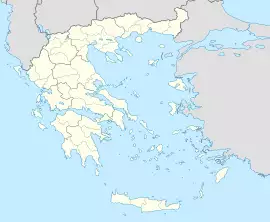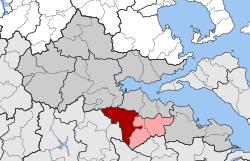Amfikleia Αμφίκλεια | |
|---|---|
| Coordinates: 38°38′N 22°35′E / 38.633°N 22.583°E | |
| Country | Greece |
| Administrative region | Central Greece |
| Regional unit | Phthiotis |
| Municipality | Amfikleia-Elateia |
| • Municipal unit | 229.37 km2 (88.56 sq mi) |
| Population (2011)[1] | |
| • Municipal unit | 4,186 |
| • Municipal unit density | 18/km2 (47/sq mi) |
| Community | |
| • Population | 3,191 (2011) |
| • Area (km2) | 108.12 |
| Time zone | UTC+2 (EET) |
| • Summer (DST) | UTC+3 (EEST) |
| Vehicle registration | ΜΙ |
Amfikleia (Greek: Αμφίκλεια, before 1915: Δαδί - Dadi[2]) is a town and a former municipality in Phthiotis, Greece. Since the 2011 local government reform it is part of the municipality Amfikleia-Elateia, of which it is a municipal unit.[3] The municipal unit has an area of 229.366 km2, the community 108.124 km2.[4] At the 2011 census, the population of the municipal unit was 4,186 and of the community 3,191.[1] The town is situated at the northern foot of Mount Parnassus, in the valley of the river Cephissus.[5] It is 11 km northwest of Kato Tithorea and 31 km southeast of Lamia. Greek National Road 3 (Thebes - Lamia) passes through the town. The town is servered by a railway station with connections on the Athens–Thessaloniki railway.
Subdivisions
The municipal unit Amfikleia consists of the following communities:
- Amfikleia
- Bralos
- Drymaia
- Palaiochori
- Tithroni
- Xylikoi
History
Amfikleia was named after the ancient town Amphicleia (Ancient Greek: Ἀμφίκλεια). Amphicleia was also named Amphicaea (Ἀμφίκαια) and Ophiteia (Ὀφιτεία). It was situated in the north of ancient Phocis.[6] The Persians under Xerxes destroyed the city in 480 BC during the second Persian invasion of Greece.[7] It was rebuilt afterwards, and at the time of Pausanias (2nd century AD), it was known for the worship of Dionysus.[6][8]
During the Middle Ages, a tower was built on the site of the acropolis. Today the site is occupied by the cemetery.[5]
The town Dadi, which was founded near the site of ancient Amphicleia, was renamed to Amfikleia in 1915.[2]
Notable people
- Athanasios Eftaxias (1849–1931), politician
Gallery
External links
- Municipality of Amfikleia-Elateia (in Greek)
References
- ^ a b c "Απογραφή Πληθυσμού - Κατοικιών 2011. ΜΟΝΙΜΟΣ Πληθυσμός" (in Greek). Hellenic Statistical Authority.
- ^ a b "Πανδέκτης: Dadi -- Amfikleia". Retrieved 21 October 2010.
- ^ Kallikratis law Greece Ministry of Interior (in Greek)
- ^ "Population & housing census 2001 (incl. area and average elevation)" (PDF) (in Greek). National Statistical Service of Greece. Archived from the original (PDF) on 2015-09-21.
- ^ a b Koder, Johannes; Hild, Friedrich (1976). Tabula Imperii Byzantini, Band 1: Hellas und Thessalia (in German). Vienna: Verlag der Österreichischen Akademie der Wissenschaften. p. 122. ISBN 978-3-7001-0182-6.
- ^ a b
 Smith, William, ed. (1854–1857). "Amphicaea". Dictionary of Greek and Roman Geography. London: John Murray.
Smith, William, ed. (1854–1857). "Amphicaea". Dictionary of Greek and Roman Geography. London: John Murray. - ^ Herodotus, Histories 8.33
- ^ Pausanias, Description of Greece 10.33.9-11



